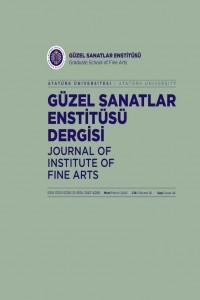Yerel Değerler Bağlamında Bir Tasarım Ürünü Olarak Turistik Hediyelik Eşya
Turistik hediyelik eşyalar, ticari olarak üretilen ve satın alınan, satın alan kişiye deneyimini hatırlatmak üzere evrensel olarak turizm ile ilişkili ürünlerdir. Turist için bu ürünler hafıza taşıyıcı olmanın ötesinde, kişinin zevklerinin göstergesi olmaktadır. Bu sebeple özgünlük arayışı vazgeçilmezdir, ancak ürünler turistik satışa yönelik kurgulanarak tek tipleşmiştir. Söz konusu ürünler, algılanan özgünlükleri bağlamında nasıl değer kazanabilecektir? Turizm kentlerindeki hediyelik eşya örneklerinin incelenmesi sonucu; yerel ürün/üretim yöntemlerinin sahiplenilmesi dolayısıyla yerel mirasın korunması, yerel zanaatkar-tasarımcı iş birliğinin güçlendirilerek yerelde istihdamları, böylece yaratıcı girişimciliğin teşvik edilmesi ile yaratıcı ekonominin beslenmesinin gelişmeyi sürdürülebilir kılacağı öngörülmektedir.
Anahtar Kelimeler:
Hediyelik Eşya, Yerel Ürün, Tasarım, Özgünlük, Turizm
Souvenir as Design Object in the Context of Local Values
Souvenirs are universally associated with tourism as a commercially produced and purchased object to remind the purchaser of the experience. Beyond being a memory holder for tourists, these products signify personal tastes. Therefore, seeking authenticity is essential, yet products made just for touristic sale became all alike. How will these products gain value in context of perceived authenticity? As a result of analyzing souvenir examples in touristic cities; preserving legacy by embracing local product/production methods, generate employment by empowering local craftsmen-designer collaboration to promote creative entrepreneurship and in turn sustainable development of creative economies is estimate.
Keywords:
Souvenir, Local Product, Design, Authenticity, Tourism,
___
- Anderson, L. F. & Littrell M. A. (1995). Souvenir-purchase behavior of women tourists. Annals of Tourism Research, 22, 328-348. Erişim adresi:https://www.cabdirect.org/cabdirect/abstract/19961801296
- Asplet, M. & Cooper M. (2000). Cultural designs in New Zealand souvenir clothing: The question of authenticity. Tourism Management, 21, 307-312. doi: https://doi.org/10.1016/S0261-5177(99)00061-8
- Blundell, V. (1993). Aboriginal empowerment and souvenir trade in Canada. Annals of Tourism Research, 20, 64-87. doi: https://doi.org/10.1016/0160-7383(93)90112-G
- Chen Design Associates. (2011). Fingerprint No.2 The evolution of handmade elements in graphic design. Ohio: HOW Books.
- Cohen, J. H. (2001). Textile, tourism and community development. Annals of Tourism Research, 28, 378-398. doi: https://doi.org/10.1016/S0160-7383(00)00060-8
- Coşar, M. (2008). Türk kültüründe hediyenin algılanışı. İÜ Türk Dili ve Edebiyatı Dergisi, 38, 33-48.
- Gordon, B. (1986). The souvenir: Messenger of the extraordinary. Journal of Popular Culture, 20, 135-146. doi: https://doi.org/10.1111/j.0022-3840.1986.2003_135.x
- Graburn, N.H. (1976). Ethnic tourist arts: Cultural expressions from the fourth world. Berkeley: University of California Press.
- Kim S., & Littrell M. A. (1999). Predicting souvenir purchase ıntentions. Journal of Travel Research, 38, 153-162. doi: https://doi.org/10.1177/004728759903800208
- Lasusa, D. M. (2007). Eiffel Tower key chains and other pieces of reality: The philosophy of souvenirs. The Philosophical Forum 38, 271–287. doi: https://doi.org/10.1111/j.1467-9191.2007.00267.x
- Littrell, M. A., Anderson L. F., & Brown P. J. (1993). What makes a craft souvenir authentic?. Annals of Tourism Research, 20, 197-215. doi: https://doi.org/10.1016/0160-7383(93)90118-M
- Mauss, M. (1966). The Gift: Forms and Functions of Exchange in Archaic Societies. ( I. Cunnison, Çev.). London: Cohen&West.
- Swanson, K. K., & Horridge P. E. (2002). Tourists’ souvenir purchase behavior and retailers’ awareness of tourists’ purchase behavior in the southwest. Clothing and Textiles Research Journal, 20(2), 62-76. doi: https://doi. org/10.1177/0887302X0202000202
- Swanson, K. K., & Horridge P. E. (2004). A structural model for souvenir consumption, travel activities and tourist demographics. Journal of Travel Research, 42, 372-380. doi: https://doi.org/10.1177/0047287504263031
- Swanson, K. K., & Horridge, P.E. (2006). Travel motivations as souvenir purchase ındicators.Tourism Management, 27, 671–683. doi: https://doi.org/10.1016/j.tourman.2005.03.001
- Swanson, K. K., & Timothy D.J. (2012). Souvenirs: Icons of meaning, commercialization and commoditization. Tourism Management, 33, 489-499. doi: https://doi.org/10.1016/j.tourman.2011.10.007
- Yu, H., & Littrell M. A (2003). Product and process orientations to tourism shopping. Journal of Travel Research, 42, 140-150. doi: https://doi.org/10.1177/0047287503257493
- ISSN: 1300-9206
- Yayın Aralığı: Aylık
- Yayıncı: Atatürk Üniversitesi
Sayıdaki Diğer Makaleler
Antik Dönem Ege Uygarlıkları Seramiklerinde Homeros’un İlyada Destanından Seçilmiş Sahne Tasvirleri
Mimari Sunum Paftalarında Görsel Tasarım İlkelerinin Uygulanması Üzerine Öneriler
Kitap Tasarımında Ortak Yazarlık
Bakü Halı Müzesi’ndeki Çuvallar
Ashkan RAHMANI, Majid Reza MOGHANIPOUR
Osmanlı Sarayında Bir Emanet: Uluğ Bey Sandığı
Türk Sineması ve Şiddet: Son Dönem Türk Filmlerinde Şiddetin Sunumu Üzerine Bir Araştırma
Mehmet Zeki İbrahimgil, Funda NALDAN
Yerel Değerler Bağlamında Bir Tasarım Ürünü Olarak Turistik Hediyelik Eşya
İzleyicinin Değişen Konumu: Katılımcı Sanat Pratikleri ve İktidarın Paylaşımı
